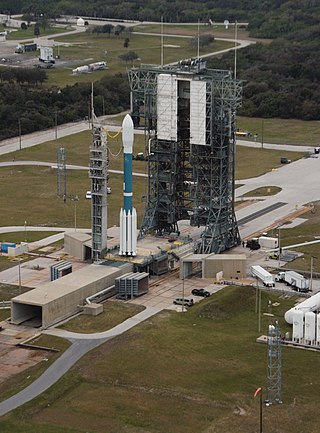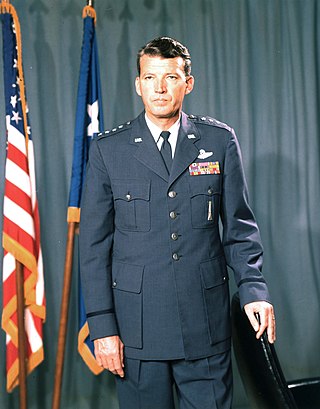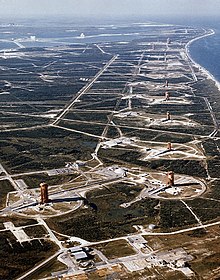
The John F. Kennedy Space Center, located on Merritt Island, Florida, is one of the National Aeronautics and Space Administration's (NASA) ten field centers. Since December 1968, KSC has been NASA's primary launch center of human spaceflight, research, and technology. Launch operations for the Apollo, Skylab and Space Shuttle programs were carried out from Kennedy Space Center Launch Complex 39 and managed by KSC. Located on the east coast of Florida, KSC is adjacent to Cape Canaveral Space Force Station (CCSFS). The management of the two entities work very closely together, share resources and operate facilities on each other's property.
The SM-65 Atlas was the first operational intercontinental ballistic missile (ICBM) developed by the United States and the first member of the Atlas rocket family. It was built for the U.S. Air Force by the Convair Division of General Dynamics at an assembly plant located in Kearny Mesa, San Diego.

Cape Canaveral Space Force Station (CCSFS) is an installation of the United States Space Force's Space Launch Delta 45, located on Cape Canaveral in Brevard County, Florida.

Gemini 2 was the second spaceflight of the American human spaceflight program Project Gemini, and was launched and recovered on January 19, 1965. Gemini 2, like Gemini 1, was an uncrewed mission intended as a test flight of the Gemini spacecraft. Unlike Gemini 1, which was placed into orbit, Gemini 2 made a suborbital flight, primarily intended to test the spacecraft's heat shield. It was launched on a Titan II GLV rocket. The spacecraft used for the Gemini 2 mission was later refurbished into the Gemini B configuration, and was subsequently launched on another suborbital flight, along with OPS 0855, as a test for the US Air Force Manned Orbital Laboratory. Gemini spacecraft no. 2 was the first craft to make more than one spaceflight since the X-15, and the only one until Space Shuttle Columbia flew its second mission in 1981; it would also be the only space capsule to be reused until Crew Dragon Endeavour was launched a second time in 2021.

Launch Complex 39 (LC-39) is a rocket launch site at the John F. Kennedy Space Center on Merritt Island in Florida, United States. The site and its collection of facilities were originally built as the Apollo program's "Moonport" and later modified for the Space Shuttle program.

Launch Complex 34 (LC-34) is a deactivated launch site on Cape Canaveral Space Force Station, Florida. LC-34 and its companion LC-37 to the north were used by NASA from 1961 through 1968 to launch Saturn I and IB rockets as part of the Apollo program. It was the site of the Apollo 1 fire, which claimed the lives of astronauts Gus Grissom, Ed White, and Roger Chaffee on January 27, 1967. The first crewed Apollo launch — Apollo 7 on October 11, 1968 — was the last time LC-34 was used.

Space Launch Complex 17 (SLC-17), previously designated Launch Complex 17 (LC-17), was a launch site at Cape Canaveral Air Force Station (CCAFS), Florida used for Thor and Delta launch vehicles launches between 1958 and 2011.

Space Launch Complex 41 (SLC-41), previously Launch Complex 41 (LC-41), is an active launch site at Cape Canaveral Space Force Station. As of 2024, the site is used by United Launch Alliance (ULA) for Atlas V and Vulcan Centaur launches. Previously, it had been used by the USAF for Titan III and Titan IV launches.

Launch Complex 14 (LC-14) is a launch site at Cape Canaveral Space Force Station in Florida. LC-14 was used for various crewed and uncrewed Atlas launches, including the February 1962, Friendship 7 flight aboard which John Glenn became the first American to orbit the Earth.

The Eastern Range (ER) is an American rocket range (Spaceport) that supports missile and rocket launches from the two major launch heads located at Cape Canaveral Space Force Station and the Kennedy Space Center (KSC), Florida. The range has also supported Ariane launches from the Guiana Space Centre as well as launches from the Wallops Flight Facility and other lead ranges. The range also uses instrumentation operated by NASA at Wallops and KSC.

Atlas is a family of US missiles and space launch vehicles that originated with the SM-65 Atlas. The Atlas intercontinental ballistic missile (ICBM) program was initiated in the late 1950s under the Convair Division of General Dynamics. Atlas was a liquid propellant rocket burning RP-1 kerosene fuel with liquid oxygen in three engines configured in an unusual "stage-and-a-half" or "parallel staging" design: two outboard booster engines were jettisoned along with supporting structures during ascent, while the center sustainer engine, propellant tanks and other structural elements remained connected through propellant depletion and engine shutdown.

The Space Launch Delta 45 is a unit of the United States Space Force. The Space Launch Delta 45 is assigned to Space Systems Command and headquartered at Patrick Space Force Base, Florida. The wing also controls Cape Canaveral Space Force Station. The 45th Space Delta is responsible for all space launch operations from the East Coast. It manages the Eastern Range, including launch activities for the Space Force, Department of Defense (DoD), NASA, and other private space corporations.

The Cape Canaveral Space Force Museum is located at Launch Complex 26 at Cape Canaveral Space Force Station, Florida. It includes artifacts from the early American space program and includes an outdoor area displaying rockets, missiles, and space-related equipment chronicling the space and missile history of the US Air Force, the US Space Force and other military branches.
The Space Tracking and Surveillance System was a pair of satellites developed by the United States Missile Defense Agency (MDA) to research the space-based detection and tracking of ballistic missiles. Data from STSS satellites could allow interceptors to engage incoming missiles earlier in flight than would be possible with other missile detection systems. The STSS program began in 2001, when the "SBIRS Low" program was transferred to MDA from the United States Air Force. In December 2002, SBIRS Low Research & Development was renamed Space Tracking and Surveillance System (STSS).

Launch Complex 13 (LC-13) was a launch complex at Cape Canaveral Space Force Station, the third-most southerly of the original launch complexes known as Missile Row, lying between LC-12 and LC-14. In 2015, the LC-13 site was leased by SpaceX and was renovated for use as Landing Zone 1 and Landing Zone 2, the company's East Coast landing location for returning Falcon 9 and Falcon Heavy launch vehicle booster stages. It is leased by US Space Force to Phantom Space and Vaya Space who will operate this launch complex after the termination of SpaceX's lease in future.

The Space Launch Complex 46 (SLC-46), previously Launch Complex 46 (LC-46), is a launch complex at Cape Canaveral Space Force Station operated under license by Space Florida previously used for Athena rocket launches. It has been used by Astra, which will continue the use with Rocket 4 and maybe 5 and will be used by ABL Space Systems for the near-term use by RS1.

The 6555th Aerospace Test Group is an inactive United States Air Force unit. It was last assigned to the Eastern Space and Missile Center and stationed at Patrick Air Force Base, Florida. It was inactivated on 1 October 1990.

While the United States Space Force gained its independence on 20 December 2019, the history of the United States Space Force can be traced back to the beginnings of the military space program following the conclusion of the Second World War in 1945. Early military space development was begun within the United States Army Air Forces by General Henry H. Arnold, who identified space as a crucial military arena decades before the first spaceflight. Gaining its independence from the Army on 18 September 1947, the United States Air Force began development of military space and ballistic missile programs, while also competing with the United States Army and United States Navy for the space mission.
















